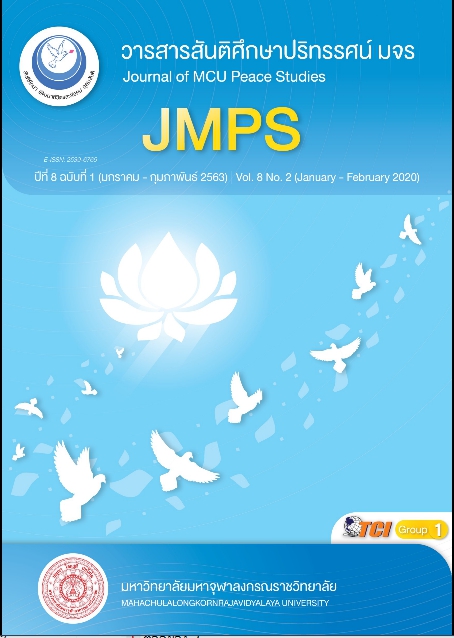แนวทางการบริหารจัดการภัยพิบัติ: จากภาครัฐสู่ชุมชน
Main Article Content
บทคัดย่อ
ภัยพิบัติ เป็นภัยที่เกิดขึ้นแก่สาธารณชน ได้แก่ อัคคีภัย วาตภัย อุทกภัย สินามิตลอดจนภัยอื่น ๆ อันเป็นสาธารณะ ไม่ว่าจะเกิดจากธรรมชาติหรือมีผู้กระทำให้เกิดขึ้น ซึ่งก่อให้เกิดอันตรายแก่ชีวิตร่างกายของประชาชน หรือความเสียหายแก่ทรัพย์สินของประชาชนหรือของรัฐ ซึ่งภัยธรรมชาติเป็นส่วนหนึ่งของภัยพิบัติ การจัดการในภาวะภัยพิบัติ เป็นกระบวนการที่เกิดขึ้นอย่างต่อเนื่องเป็นระบบ แต่สามารถยืดหยุ่นหรือเปลี่ยนแปลงได้ตาม เวลาและสถานการณ์ ครอบคลุมการปฏิบัติงานทุกขั้นตอน เพื่อให้การดำเนินงานถูกต้อง รวดเร็วและมีประสิทธิภาพ เพื่อให้สามารถช่วยเหลือผู้ประสบภัยพิบัติได้อย่างทันท่วงทีและช่วยลดผลกระทบจากความรุนแรงของภัยพิบัติที่อาจเกิดขึ้นต่อร่างกายชีวิต และทรัพย์สินของผู้ประสบภัย สภาพเศรษฐกิจ สังคม และสิ่งแวดล้อมของชาติ เพื่อให้ผู้ประสบภัยได้รับความช่วยเหลือตามหลักการสิทธิมนุษยชน หลักสิทธิพื้นฐานของผู้ประสบภัยพิบัติธรรมชาติพึงได้รับจากรัฐ เช่น สิทธิที่จะมีชีวิตอยู่ การกลับสู่ถิ่นฐานเดิม ด้านปัจจัยสี่ อาหาร น้ำดื่ม ที่อยู่อาศัย เครื่องนุ่งห่ม และด้านสุขภาพ รวมถึงมาตรการเตรียมความพร้อมเพื่อที่จะให้ความช่วยเหลือในอนาคตอย่างมีประสิทธิภาพ การให้ความช่วยเหลือทางด้านมนุษยธรรม เป็นการคุ้มครองสิทธิพื้นฐานของปัจเจกชนไม่ให้ถูกละเมิด รัฐภาคีในสนธิสัญญาสิทธิมนุษยชนจึงต้องผูกพันในการที่จะใช้ทรัพยากรที่มีร่วมกันให้มากที่สุด
Article Details
ทัศนะและความคิดเห็นที่ปรากฏในบทความในวารสาร ถือเป็นความรับผิดชอบของผู้เขียนบทความนั้น และไม่ถือเป็นทัศนะและความรับผิดชอบของกองบรรณาธิการ ยินยอมว่าบทความเป็นลิขสิทธิ์ของวารสาร
เอกสารอ้างอิง
Department of Environmental Quality Promotion. (2009). Environmental situation in Thailand in 2009 by two-year-old people. Bangkok: Environmental Information Center. Ministry of Natural Resources and Environment.
Department of National Disaster Prevention and Mitigation. (2013). Reducing risk from disaster. Bangkok: The Agricultural Cooperative Publishing House of Thailand.
Gebbie, K. M. & Qureshi, K. (2002). Emergency and Disaster Preparedness: Core competencies for Nurses: What every nurse should but may not know. American Journal of Nursing, 102(1), 46-51.
International Federation of Red Cross and Red Crescent Societies. (2000). Introduction to Disaster preparedness. Retrieved December 9, 2014, from http://www.ifrc.org/Global/ Introdp.pdf
International Federation of Red Cross and Red Crescent Societies. (2013). World Disasters Report 2013: Focus on technology and the future of humanitarian action. Geneva, Switzerland: International Federation of Red Cross and Red Crescent Societies.
Limbsiri P. (2011). Fundamental Rights of Natural Disater Victims Bangkok. Institute of Damrong Nusorn, Ministry of the Interior.
National Economic and Social Development Board. (2011). Disaster management and restoration after disaster: a case study of Thailand and other countries. Bangkok: Phet Rung Printing Center.
National Disaster Prevention and Mitigation Committee. (2010). National Disaster Prevention and Mitigation Plan 2010 - 2014. Bangkok: Department of Disaster Prevention and Mitigation. Ministry of Interior.
Thai Health Project. (2013). Thai Health 2013. Nakhon Pathom: Institute for Population and Social Research, Mahidol University.
Ubalee C. (2008). “Public Participation in Disaster Administration: A Case Study of Din Daeng Community Housing Building. Bangkok”. Master’s thesis (Public Administration Branch). Faculty of Political Science: Thammasat University.
World Health Organization. (2008). Humanitarian Health Action. Retrieved July 28, 2012, from http://www.who.-int/hac/about/definitions/en/


